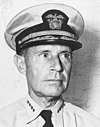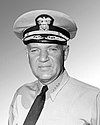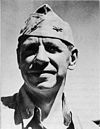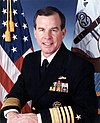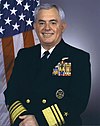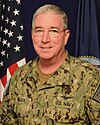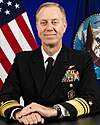United States Fifth Fleet
 From Wikipedia - Reading time: 20 min
From Wikipedia - Reading time: 20 min
This article has multiple issues. Please help improve it or discuss these issues on the talk page. (Learn how and when to remove these messages)
|
| Fifth Fleet | |
|---|---|
 The U.S. Fifth Fleet's emblem | |
| Active |
|
| Country | |
| Branch | |
| Part of |
|
| Garrison/HQ | Naval Support Activity Bahrain, Bahrain |
| Engagements | |
| Battle honours | Pacific Theatre of World War II |
| Commanders | |
| Current commander | VADM George Wikoff |
| Command Master Chief | CMDCM Franklin P. Call |
| Notable commanders | ADM Raymond A. Spruance, USN |
The Fifth Fleet is a numbered fleet of the United States Navy. Its area of responsibility encompasses approximately 2.5 million square miles, and includes the Persian Gulf, Red Sea, Arabian Sea, and parts of the Indian Ocean. It shares a commander and headquarters with U.S. Naval Forces Central Command (NAVCENT) in Bahrain. Fifth Fleet/NAVCENT is a component command of, and reports to, U.S. Central Command (CENTCOM).
Established during World War II in 1944, the Fifth Fleet conducted extensive operations that led to the defeat of Japanese forces in the Central Pacific, including battles for the Mariana Islands campaign, Iwo Jima, and Okinawa. In 1947, two years after the Allied victory, it was stood down. After remaining inactive for 48 years, the Fifth Fleet was reactivated in 1995. It contributed significant forces in the Global War on Terrorism and continues to project US naval power in the Middle East.
World War II
[edit]The Fifth Fleet was initially established during World War II on 26 April 1944 from the Central Pacific Force under the command of Admiral Raymond Spruance. Central Pacific Force was itself part of Pacific Ocean Areas. The ships of the Fifth Fleet also formed the basis of the Third Fleet, which was the designation of the "Big Blue Fleet" when under the command of Admiral William F. Halsey, Jr.[N 1] Spruance and Halsey would alternate command of the fleet for major operations, allowing the other admiral and his staff time to prepare for the subsequent one. A secondary benefit was confusing the Japanese into thinking that they were actually two separate fleets as the fleet designation flipped back and forth. Under Admiral Spruance, the Fifth Fleet was, by June 1944, the largest combat fleet in the world, with 535 warships.[2]
While operating under Spruance's command as the Fifth Fleet, the fleet took part in the Mariana Islands campaign of June–August 1944, the Iwo Jima campaign of February–March 1945, and the Okinawa campaign of April–June 1945. During the course of these operations, it conducted Operation Hailstone (a major raid against the Japanese naval base at Truk) in February 1944, defeated the Imperial Japanese Navy in the Battle of the Philippine Sea in June 1944, and blunted the Japanese Operation Ten-Go – sinking the Japanese battleship Yamato in the process – in April 1945.
Halsey then relieved Spruance of command and the British ships, like the rest of the Fifth Fleet, were resubordinated to the Third Fleet.
The Atomic bombings of Hiroshima and Nagasaki made this any further operations unnecessary, and the Fifth Fleet did not return to combat again during the war.
The commanders of Fifth Fleet during this era were Admirals Spruance (26 April 1944 – 8 November 1945), John Henry Towers (8 November 1945 – 18 January 1946), Frederick C. Sherman (18 January 1946 – 3 September 1946), and Alfred E. Montgomery (5 September 1946 – 1 January 1947).[3] The Fifth Fleet was deactivated in January 1947. The position of Commander, Fifth Fleet, became Commander, First Task Fleet. Montgomery became Commander, First Task Fleet, upon the deactivation of the Fifth Fleet.
In the Middle East after 1995
[edit]Prior to the first Gulf War in 1990–1991, U.S. naval operations in the Persian Gulf region were directed by the Commander, Middle Eastern Force (COMMIDEASTFOR). Since this organization was considered insufficient to manage large-scale combat operations during the Gulf War, the Seventh Fleet — primarily responsible for the Western Pacific and Indian Ocean and normally based in Japan – was given the temporary task of managing the force during the period. However, no numbered fleet existed permanently within the USCENTCOM area of responsibility. In 1995, John Scott Redd proposed and founded the only new U.S. Navy Fleet in half a century, serving as the first Commander, Fifth Fleet (COMFIFTHFLT) since World War II.[4][5] After a 48-year hiatus, the Fifth Fleet was reactivated, replacing COMMIDEASTFOR, and it now directs operations in the Persian Gulf, Red Sea, and Arabian Sea. Its headquarters are at NSA Bahrain located in Manama, Bahrain.

For the early years of its existence, its forces normally consisted of an Aircraft Carrier Battle Group (CVBG), an Amphibious Ready Group (ARG), surface combatants, submarines, maritime patrol and reconnaissance aircraft, and logistics ships. However, with the War on Terrorism, the naval strategy of the U.S. has changed. The regular deployments of the Cold War are now a thing of the past. Consequently, the policy of always maintaining a certain number of ships in various parts of the world is also over. However, its usual configuration now includes a Carrier Strike Group (CSG), Amphibious Ready Group or Expeditionary Strike Group (ESG), and other ships and aircraft with almost 15,000 people serving afloat and 1,000 support personnel ashore.[6]
Carrier Strike Group Three formed the core of the naval power during the initial phase of Operation Enduring Freedom in 2001. Commander, Carrier Group Three, Rear Admiral Thomas E. Zelibor, arrived in the Arabian Sea on 12 September 2001 and was subsequently designated Commander Task Force 50 (CTF 50), commanding multiple carrier strike groups and coalition forces. The Task Force conducted strikes against Al-Qaeda and Taliban forces in Afghanistan. Task Force 50 comprised over 59 ships from six nations including six aircraft carriers, stretching over 800 nautical miles.[7]
Naval operations in the Middle East were the subject of DOD Exercise Millennium Challenge 2002, during which unanticipated maneuvers by opposing forces director Lieutenant General Paul Van Riper USMC (retd.) led to heavy losses to the 'imaginary' exercise U.S. fleet.[8]
Fifth Fleet forces peaked in early 2003, when five USN aircraft carriers (CV and CVNs), six USN amphibious assault ships (LHAs and LHDs) and their embarked USMC air ground combat elements, their escorting and supply vessels, and over 30 Royal Navy vessels were under its command.
In the Persian Gulf, United States Coast Guard surface ships attached to the Fifth Fleet were under Commander, Destroyer Squadron 50 (CDS-50) commanded by Captain John W. Peterson of the Navy.[9] Coast Guard cutters Boutwell, Walnut, and the four patrol boats were part of this group. The shore detachments, MCSD and Patrol Forces Southwest Asia also operated under the command of CDS-50. For actual operations, the Coast Guard forces were part of two different task forces. The surface units were part of Task Force 55 (CTF-55). Command of CTF-55 actually shifted during OIF. Initially, Rear Admiral Barry M. Costello, Commander of the Constellation Battle Group, commanded CTF-55. The surface forces were designated Task Group 55.1 (TG-55.1) with Commander Destroyer Squadron 50 (CDS-50) as the task group commander. In mid-April, the Constellation Battle Group left the NAG and the Destroyer Squadron 50 staff commanded TF-55 for the remainder of OIF major combat operations. In the aftermath of the fall of Baghdad in April 2003, the very large force of ships was quickly drawn down.
On 3 January 2012, following the end of the ten-day Velayat 90 naval maneuvers by the Iranian Navy in the Strait of Hormuz, the Iranian Army chief of staff, General Ataollah Salehi, was quoted by the state news agency IRNA as warning the United States to not deploy John C. Stennis back to the Persian Gulf.[10][11] On 4 January 2011, Fars News Agency reported that a bill was being prepared for the Iranian Parliament to bar foreign naval vessels from entering the Persian Gulf unless they receive permission from the Iranian navy, with Iranian lawmaker Nader Qazipour noting: "If the military vessels and warships of any country want to pass via the Strait of Hormuz without coordination and permission of Iran's navy forces, they should be stopped by the Iranian armed forces."[12] Also, Iranian Defense Minister Ahmad Vahidi reiterated that "transnational forces" have no place in the Persian Gulf region.[12] On 6 January 2012, armed Iranian speedboats reportedly harassed two U.S. naval vessels, the amphibious transport dock New Orleans and the Coast Guard cutter Adak, as they transited the Strait of Hormuz into the Persian Gulf.[13]
On 9 January 2012, Carrier Strike Group One, led by the carrier Carl Vinson, joined Carrier Strike Group Three in the North Arabian Sea, with Carrier Strike Group Nine, led by the carrier Abraham Lincoln, en route to the Arabian Sea amid rising tension between the United States and the Islamic Republic of Iran over U.S. naval access to the Strait of Hormuz.[14] On 19 January 2012, Carrier Strike Group Nine entered the Fifth Fleet's area of responsibility (AOR) and relieved Carrier Strike Group Three.[15] That same day during an interview on the Charlie Rose program, Mohammad Khazaee, Iran's ambassador to the United Nations, stated that Iran would consider closing the Strait of Hormuz if Iran's security was endangered.[16]
For December 2012 and January 2013, Carrier Strike Group Three was the only carrier strike group operating with the U.S. Fifth Fleet until relieved by the Carrier Strike Group Ten. This is because of the temporary two-month rotation of the Carrier Strike Group Eight back to the United States in order to resurface the flight deck of that group's flagship, the carrier Eisenhower.[17] Dwight D. Eisenhower, Carrier Air Wing Seven, and the guided-missile cruiser Hue City returned to base on 19 December 2012, and the guided missile destroyers Jason Dunham, Farragut, and Winston S. Churchill were scheduled to return to base in March 2013.[18]
In September 2016, Commander Amphibious Task Group, Commodore Andrew Burns, set off from the UK with Ocean, along with helicopters from 845 Naval Air Squadron, No. 662 Squadron AAC and No. 27 Squadron RAF, Bulwark, and element of 3 Commando Brigade HQ Royal Marines, RFA Mounts Bay and MV Eddystone Point under his flag. This deployment was known as the Joint Expeditionary Force (Maritime) 2016. The Amphibious Task Group was planned to sail to the Red Sea and Persian Gulf, where Burns was to assume command of the United States Fifth Fleet Task Force 50 until March 2017.[19][20]
On 1 December 2018, Commander, Fifth Fleet, Vice Admiral Scott A. Stearney was found dead in his residence in Bahrain. No foul play was suspected. Deputy commander Rear Admiral Paul J. Schlise assumed command in his place.[21][22] Vice Admiral Jim Malloy flew to Bahrain to provide support.[23][24] Malloy was formally nominated to succeed Stearney on 4 December[24][25][26] and quickly confirmed by voice vote of the full United States Senate on 6 December.[25][27][28] Vice Adm. Malloy assumed command on 7 December.[29]
Composition
[edit]
- Task Force 50, Battle Force (~1 x Forward Deployed Carrier Strike Group). From 2010 through 2013, the U.S. maintained two aircraft carriers east of Suez, known as a "2.0 carrier presence," although it sometimes temporarily dipped below that level.[30] The heightened presence aimed to provide air and sea striking power for U.S. operations in Iraq and Afghanistan, to deter Iran from problematic behavior in the region and keep the Strait of Hormuz open.
- Task Force 51, Amphibious Force (~1 x Expeditionary Strike Group)/Expeditionary Strike Group Five/TF 59 (Manama, Bahrain)
- Task Force 52, mining/demining force
- Task Force 53, Logistics Force[31]/Sealift Logistics Command Central, Military Sealift Command (MSC replenishment ships plus USN MH-53E Sea Stallion helicopters and C-130 Hercules, C-9 Skytrain II and/or C-40 Clipper aircraft)
- Task Force 54, (dual-hatted as Task Force 74) Submarine Force
- Task Force 55, Operation Iraqi Freedom: USS Constellation (CV-64) Carrier Strike Force; June 2003: mine clearing force, including elements from the U.S. Navy Marine Mammal Program. At the end of February 2003, Ponce (AFSB/I-15), became the flagship of the Commander of Mine Countermeasure Squadron Three, designated as Commander, Task Group 55.4. The Task Group included a US Navy special clearance team, two explosive ordnance disposal (EOD) units, a detachment of MH-53E Sea Dragon helicopters from Helicopter Mine Countermeasures Squadron FOURTEEN (HM-14), a British unit and Clearance Diving Team 3, from the Australian Clearance Diving Branch. The ships involved included the mine coastal hunters Cardinal and Raven, mine countermeasure ships Ardent and Dextrous, and dock landing ship Gunston Hall. TF 55's previous activities during World War II were as the U.S. Marine expeditionary component of the Central Pacific's Fifth Fleet.
- Task Force 56, Navy Expeditionary Combat Command force.[32]
- CTG 56.1 Explosive Ordnance Disposal / Expeditionary Diving and Salvage[33]
- CTG 56.2 Naval Construction Forces
- CTG 56.3 Navy Expeditionary Logistics Support Group Forward; NSA Bahrain. Provides logistics support for USN/USA/USMC, cargo movement and customs throughout the area of responsibility.
- CTG 56.4 U.S. Army Civil Affairs
- CTG 56.5 Maritime Expeditionary Security; Provides anti-Terrorism/Force Protection of land/port/littoral waterway operations for USN and Coalition assets, as well as point defense of strategic platforms and MSC vessels
- CTG 56.6 Expeditionary Combat Readiness; Provides administrative "Sailor support" for all Individual Augmentees, and administers the Navy Individual Augmentee Combat Training Course and Warrior Transition Program
- CTG 56.7 Riverine; Provides riverine protection of waterways from illegal smuggling of weapons, drugs and people
- Task Force 57, (dual-hatted as Task Force 72) Patrol and Reconnaissance Force (P-3 and EP-3 Maritime Patrol and Reconnaissance Aircraft)
- Task Group 57.1 – Lockheed EP-3, VQ-1[34]
- Task Group 57.2 – in October 2006, consisted of VP-8, VP-9, VP-16, and VP-46.[35]
- Note that as of 13 October 2011, Officer in Charge, Patrol and Reconnaissance Force Fifth Fleet Det Bahrain (COMPATRECONFORFIFTHFLT DET BAHRAIN (44468)) has been modified to Commander, Patrol and Reconnaissance Wing FIVE SEVEN.[36]
- Task Force 58, Maritime Surveillance Force (Northern Persian Gulf)
- Task Force 59, Expeditionary Force/Contingency Force (when required, e.g. July–August 2006 Lebanon evacuation operation, in conjunction with Joint Task Force Lebanon) In February 2007 it was conducting Maritime Security Operations[37] and as of 2 November 2007, it was running a crisis management exercise.
Coalition Forces Maritime Component Command
[edit]Together with Naval Forces Central Command, Fifth Fleet oversees four naval task forces monitoring maritime activity:
- Combined Task Force 150 that patrols from Hormuz, halfway across the Arabia Sea, South as far as the Seychelles, through the Gulf of Aden, up through the strait between Djibouti and Yemen known as the Bab Al Mandeb and into the Red Sea and, finally, around the Horn of Africa;
- Combined Task Force 152 patrols the Persian Gulf from the northern end where area of responsibility of CTF 158 ends and down to the Strait of Hormuz between Oman and Iran where the area of responsibility for CTF 150 begins;
- Combined Task Force 151 patrols mostly the same area as CTF 150 but is primarily focused on deterring and disrupting Somali piracy attack on commercial shipping and leisure craft;
- CTF 52 (as above) patrols the same area as CTF 152 but is focused on countermining/demining activity.[38]
Commanders
[edit]The United States Navy, Naval Historical Center advises that;
"..This position was originally titled Commander, Central Pacific Force. On 26 April 1944 it was renamed Commander, Fifth Fleet. It then became Commander, First Task Fleet on 1 January 1947."[39]
List of commanders
[edit]Original fleet (1944–1947)
[edit]| No. | Commander | Term | Ref | |||
|---|---|---|---|---|---|---|
| Portrait | Name | Took office | Left office | Term length | ||
| 1 | Admiral Raymond A. Spruance (1886–1969) | 26 April 1944[40] | 8 November 1945 | 1 year, 196 days | [41] | |
| 2 | Admiral John Henry Towers (1885–1955) | 8 November 1945 | 18 January 1946 | 71 days | [41] | |
| 3 | Vice Admiral Frederick C. Sherman (1888–1957) | 18 January 1946 | 3 September 1946 | 228 days | [41] | |
| 4 | Vice Admiral Alfred E. Montgomery (1891–1961) | 5 September 1946 | 1 January 1947[42] | 118 days | [41] | |
Current fleet (1995–present)
[edit]| No. | Commander | Term | Ref | |||
|---|---|---|---|---|---|---|
| Portrait | Name | Took office | Left office | Term length | ||
| 1 | Vice Admiral John Scott Redd (born 1944) | 1 July 1995[43] | June 1996 | ~336 days | [44] | |
| 2 | Vice Admiral Thomas B. Fargo (born 1948) | June 1996 | 27 July 1998 | ~2 years, 56 days | [45] | |
| 3 | Vice Admiral Charles W. Moore Jr. (born 1946) | 27 July 1998 | 11 February 2002 | 3 years, 199 days | [46] | |
| 4 | Vice Admiral Timothy J. Keating (born 1948) | 11 February 2002 | 7 October 2003 | 1 year, 238 days | [47] | |
| 5 | Vice Admiral David C. Nichols (born 1950) | 7 October 2003 | 3 November 2005 | 2 years, 27 days | [47] | |
| 6 | Vice Admiral Patrick M. Walsh (born 1955) | 3 November 2005 | 27 February 2007 | 1 year, 116 days | [47] | |
| 7 | Vice Admiral Kevin J. Cosgriff | 27 February 2007 | 5 July 2008 | 1 year, 129 days | [48] | |
| 8 | Vice Admiral William E. Gortney (born 1955) | 5 July 2008 | 5 July 2010 | 2 years, 0 days | [49] | |
| 9 | Vice Admiral Mark I. Fox (born 1956) | 5 July 2010 | 24 May 2012 | 1 year, 324 days | [50] | |
| 10 | Vice Admiral John W. Miller | 24 May 2012 | 3 September 2015 | 3 years, 102 days | [51] | |
| 11 | Vice Admiral Kevin M. Donegan (born 1958) | 3 September 2015 | 19 September 2017 | 2 years, 16 days | [52] | |
| 12 | Vice Admiral John C. Aquilino (born 1962) | 19 September 2017 | 6 May 2018 | 229 days | [53] | |
| 13 | Vice Admiral Scott Stearney (1960–2018) | 6 May 2018 | 1 December 2018 | 209 days | [54] | |
| - | Rear Admiral (lower half) Paul J. Schlise Acting | 1 December 2018 | 7 December 2018 | 6 days | - | |
| 14 | Vice Admiral James J. Malloy (born 1963) | 7 December 2018 | 19 August 2020 | 255 days | [55] | |
| 15 | Vice Admiral Samuel Paparo (born 1964) | 19 August 2020 | 5 May 2021 | 1 year, 259 days | [56] | |
| 16 | Vice Admiral Charles Cooper II (born 1967) | 5 May 2021 | 1 February 2024 | 2 years, 272 days | [57] | |
| 17 | Vice Admiral George M. Wikoff (born 1968) | 1 February 2024 | Incumbent | 295 days | - | |
References
[edit]- Notes
- ^ The "Big Blue Fleet" was the name given to the main fleet of the U.S. Navy in the Pacific. The term stems from pre-war planning, called the "color plans" because each nation included was given a color code name. In these plans for potential conflicts, the British Royal Navy was "Red," the German Navy was "Black," and so forth. The Imperial Japanese Navy was termed the "Orange Fleet," while the U.S. fleet was the "Blue Fleet". The "Big Blue Fleet" was the massive fleet that the U.S. Navy anticipated it would field to win a war with Japan and which it thought largely would come into being by late 1943 or early 1944.[1]
- Citations
- ^ Potter p. 112
- ^ Beevor, Antony (2013). The Second World War (in Norwegian) (1st ed.). Cappelen Damm. p. 609. ISBN 978-82-02-42146-5.
- ^ "Fifth Fleet Commanders". 7 November 2012. Archived from the original on 7 November 2012.
- ^ "Fifth Fleet". globalsecurity.org. Retrieved 25 October 2010.
- ^ Barbara Starr, 'US Fifth Fleet reborn for active duty in the Persian Gulf, Jane's Defence Weekly, 27 May 1995, p.11
- ^ "Fifth Fleet". Globalsecurity.org.
- ^ Adkins, Mark; John Kruse (3 August 2003). "Case Study: Network Centric Warfare in the U.S. Navy's Fifth Fleet Web-Supported Operational Level Command and Control in Operation Enduring Freedom" (PDF). Center for the Management of Information. University of Arizona. Retrieved 23 February 2011.
- ^ "Limpet mines and mini subs: Iran's war of naval sabotage could spin out of control". 11 April 2021.
- ^ Center for Naval Analyses 'Coast Guard Operations during Operation Iraqi Freedom'
- ^ Parisa Hafezi (3 January 2012). "Iran threatens U.S. Navy as sanctions hit economy". Reuters. Retrieved 4 January 2012.
- ^ Joby Warrick & Steven Mufson (3 January 2012). "Iran threatens U.S. ships, alarms oil markets". National Security. The Washington Post. Retrieved 4 January 2012. and Nasser Karimi (3 January 2012). "Iran warns US carrier: Don't come back to Gulf". Stars and Stripes. Associated Press. Archived from the original on 4 January 2012. Retrieved 4 January 2012.
- ^ a b Thomas Erdbrink (4 January 2012). "Iran prepares bill to bar foreign warships from Persian Gulf". Middle East. The Washington Post. Retrieved 4 January 2012.
- ^ Barbara Starr (13 January 2012). "Official: U.S. vessels harassed by high-speed Iranian boats". CNN. Retrieved 15 January 2012.
- ^ Phil Stewart (11 January 2012). "U.S. military moves carriers, denies Iran link". Reuters. Retrieved 13 January 2012.
- ^ Mass Communication Specialist Seaman Zachary Welch (19 January 2012). "Abraham Lincoln Arrives in U.S. 5th Fleet". NNS120119-04. Carrier Strike Group 9 Public Affairs. Retrieved 19 January 2012.
- ^ Peter Hirschberg (19 January 2012). "Iran's UN Ambassador Says Closing Strait of Hormuz an Option". Bloomberg Businessweek. Archived from the original on 19 January 2012. Retrieved 19 January 2012.
- ^ Christina Silva (27 November 2012). "Faulty part on carrier has domino effect on deployments". Stars and Stripes. Retrieved 30 November 2012.
- ^ "USS Dwight D. Eisenhower, USS Hue City, Carrier Air Wing-7 Return Home". NNS121219-06. USS Dwight D. Eisenhower Public Affairs. 19 December 2012. Retrieved 7 January 2013.
- ^ "A Royal send off in Malta – Royal Navy". Retrieved 30 July 2016.
- ^ "HMS Ocean deploys on joint expeditionary force". Royal Navy. Retrieved 23 September 2016.
- ^ LaGrone, Sam (1 December 2018). "UPDATED: U.S. 5th Fleet Commander Found Dead in Bahrain – USNI News". United States Naval Institute. Retrieved 1 December 2018.
- ^ Kube, Courtney; Helsel, Phil (1 December 2018). "Navy admiral Scott Stearney found dead in Bahrain, no foul play suspected". NBC News. Retrieved 1 December 2018.
- ^ Ziezulewicz, Geoff (3 December 2018). "Three-star heads to 5th Fleet after admiral's sudden death". Navy Times. Retrieved 4 December 2018.
- ^ a b LaGrone, Sam (6 December 2018). "Vice. Adm. James Malloy Nominated to Lead 5th Fleet Following Death of Former Commander". USNI News. Retrieved 7 December 2018.
- ^ a b "PN2697 — Vice Adm. James J. Malloy — Navy". U.S. Congress. 6 December 2018. Retrieved 7 December 2018.
- ^ "Flag Officer Announcement". U.S. Department of Defense. 6 December 2018. Retrieved 7 December 2018.
- ^ "Wrap Up for Thursday, December 6, 2018". U.S. Senate. 6 December 2018. Retrieved 7 December 2018.
- ^ LaGrone, Sam (6 December 2018). "Vice. Adm. James Malloy Confirmed to Lead 5th Fleet Following Death of Former Commander". USNI News. Retrieved 7 December 2018.
- ^ U.S. 5th Fleet Public Affairs (7 December 2018). "Vice Admiral James Malloy Assumes Duties as U.S. Naval Forces Central Command/U.S. 5th Fleet Commander". U.S. 5th Fleet Public Affairs. Retrieved 8 December 2018.
{{cite web}}: CS1 maint: numeric names: authors list (link) - ^ Wong, Kristina (17 October 2015). "Navy won't have aircraft carrier in Persian Gulf as Iran deal takes effect". The Hill.
- ^ [1] Archived 17 April 2009 at the Wayback Machine
- ^ NAVCENT/Fifth Fleet Public Affairs, CTF-56 Fills Multiple Roles in Theatre Archived 14 April 2009 at the Wayback Machine, 25 January 2009. Previously SeaBee or ashore security force (CTF 59, Coalition Forces Conduct Crisis Response Exercise)
- ^ List of six task groups is from Powerpoint brief, Navy Expeditionary Combat Command: Executing Navy's Maritime Strategy, Maritime Civil Affairs Squadron TWO, 2 September 2008
- ^ Globalsecurity.org [full citation needed]
- ^ U.S. Navy, MCPON Visits Sailors in Afghanistan, 23 November 2006
- ^ [OPNAV Notice 5400 (5400.8543) Modification of Officer in Charge, Patrol and Reconnaissance Force Fifth Fleet Det Bahrain], issued 13 October 2011
- ^ Mass Communication Specialist 2nd Class Michael Zeltakalns, Commander, U.S. Naval Forces Central Command/Commander, U.S. 5th Fleet Public Affairs. "Combined Task Force 59 Welcomes New Commander". News.navy.mil. Archived from the original on 17 April 2009. Retrieved 15 January 2013.
{{cite web}}: CS1 maint: multiple names: authors list (link) CS1 maint: numeric names: authors list (link) - ^ NAVCENT/Fifth Fleet Public Affairs, Commander Task Force 52 Established Archived 14 April 2009 at the Wayback Machine, 20 January 2009
- ^ "DEPARTMENT OF THE NAVY -- NAVAL HISTORICAL CENTER". history.navy.mil. 8 December 2006. Archived from the original on 24 June 2011. Retrieved 7 December 2018.
- ^ Fifth Fleet was Central Pacific Force until re-designated on 26 April 1944.
- ^ a b c d "DEPARTMENT OF THE NAVY -- NAVAL HISTORICAL CENTER". history.navy.mil. 8 December 2006. Archived from the original on 24 June 2011. Retrieved 7 December 2018.
- ^ Command re-designated as First Task Fleet, later the United States First Fleet
- ^ Anchor of Resolve: A History of US Naval Forces Central Command (PDF). p. 41. Retrieved 18 May 2021.
- ^ Anchor of Resolve: A History of US Naval Forces Central Command (PDF). p. 40. Retrieved 18 May 2021.
- ^ "Admiral Thomas B. Fargo, U.S. Navy (Ret.)". Retrieved 18 May 2021.
- ^ "COMUSNAVCENT/COMFIFTHFLT Bio".
- ^ a b c "Vice Adm. Nichols Turns Over the Reigns to Vice Adm. Walsh [Image 3 of 3]". dvidshub.net. 3 November 2005.
- ^ "Cosgriff Assumes Command of NAVCENT, 5th Fleet". dvidshub.net. 27 February 2007.
- ^ "Cosgriff Highlights Regional Cooperation during Change of Command". dvidshub.net. 5 July 2008.
- ^ "Vice Adm. Fox Assumes Command of US Navy in Middle East". dvidshub.net. 5 July 2010.
- ^ "VICE ADM. MILLER TAKES HELM OF U.S. NAVY IN MIDDLE EAST AND COMBINED MARITIME FORCES". Combined Maritime Forces. 24 May 2012.
- ^ "Prolific fighter pilot takes over 5th Fleet". Navy Times. 8 September 2015.
- ^ "U.S. Fifth Fleet Welcomes New Commander". U.S. Naval Forces Central Command. 19 July 2019.
- ^ "VADM Stearney Takes Command of 5th Fleet; RADM Corey Takes Over PEO Unmanned Aviation and Strike Weapons". USNI News. 8 May 2018.
- ^ "Vice Admiral James Malloy Assumes Duties as U.S. Naval Forces Central Command/U.S. 5th Fleet Commander". U.S. Naval Forces Central Command. 7 December 2018.
- ^ "NAVCENT, FIFTH FLEET, CMF WELCOME NEW COMMANDER". U.S. Marine Corps. 19 August 2019.
- ^ "NAVCENT, U.S. Fifth Fleet, CMF Change of Command". U.S. Naval Forces Central Command. 6 May 2021.
- Bibliography
- Potter, E. B. (2005). Admiral Arliegh Burke. U.S. Naval Institute Press. ISBN 978-1-59114-692-6.
- Schneller, Robert J., Jr. Anchor of Resolve: A History of the U.S. Naval Forces Central Command/Fifth Fleet (Washington: Naval Historical Center, 2012), 126 pp.
 KSF
KSF